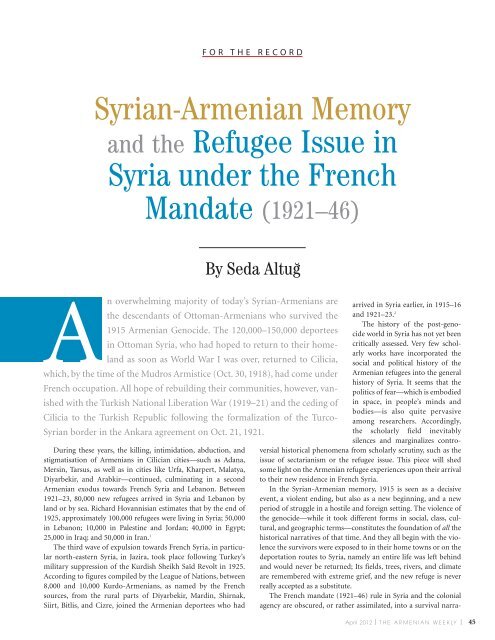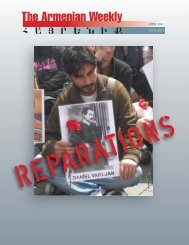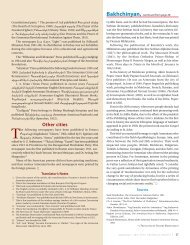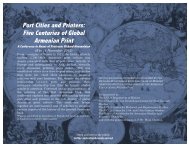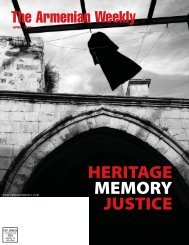Armenian Weekly April 2012 Magazine
Armenian Weekly April 2012 Magazine
Armenian Weekly April 2012 Magazine
You also want an ePaper? Increase the reach of your titles
YUMPU automatically turns print PDFs into web optimized ePapers that Google loves.
FOR THE RECORD<br />
Syrian-<strong>Armenian</strong> Memory<br />
and the Refugee Issue in<br />
Syria under the French<br />
Mandate (1921–46)<br />
By Seda Altuğ<br />
An overwhelming majority of today’s Syrian-<strong>Armenian</strong>s are<br />
the descendants of Ottoman-<strong>Armenian</strong>s who survived the<br />
1915 <strong>Armenian</strong> Genocide. The 120,000–150,000 deportees<br />
in Ottoman Syria, who had hoped to return to their homeland<br />
as soon as World War I was over, returned to Cilicia,<br />
which, by the time of the Mudros Armistice (Oct. 30, 1918), had come under<br />
French occupation. All hope of rebuilding their communities, however, vanished<br />
with the Turkish National Liberation War (1919–21) and the ceding of<br />
Cilicia to the Turkish Republic following the formalization of the Turco-<br />
Syrian border in the Ankara agreement on Oct. 21, 1921.<br />
During these years, the killing, intimidation, abduction, and<br />
stigmatisation of <strong>Armenian</strong>s in Cilician cities—such as Adana,<br />
Mersin, Tarsus, as well as in cities like Urfa, Kharpert, Malatya,<br />
Diyarbekir, and Arabkir—continued, culminating in a second<br />
<strong>Armenian</strong> exodus towards French Syria and Lebanon. Between<br />
1921–23, 80,000 new refugees arrived in Syria and Lebanon by<br />
land or by sea. Richard Hovannisian estimates that by the end of<br />
1925, approximately 100,000 refugees were living in Syria; 50,000<br />
in Lebanon; 10,000 in Palestine and Jordan; 40,000 in Egypt;<br />
25,000 in Iraq; and 50,000 in Iran. 1<br />
The third wave of expulsion towards French Syria, in particular<br />
north-eastern Syria, in Jazira, took place following Turkey’s<br />
military suppression of the Kurdish Sheikh Saïd Revolt in 1925.<br />
According to figures compiled by the League of Nations, between<br />
8,000 and 10,000 Kurdo-<strong>Armenian</strong>s, as named by the French<br />
sources, from the rural parts of Diyarbekir, Mardin, Shirnak,<br />
Siirt, Bitlis, and Cizre, joined the <strong>Armenian</strong> deportees who had<br />
arrived in Syria earlier, in 1915–16<br />
and 1921–23. 2<br />
The history of the post-genocide<br />
world in Syria has not yet been<br />
critically assessed. Very few scholarly<br />
works have incorporated the<br />
social and political history of the<br />
<strong>Armenian</strong> refugees into the general<br />
history of Syria. It seems that the<br />
politics of fear—which is embodied<br />
in space, in people’s minds and<br />
bodies—is also quite pervasive<br />
among researchers. Accordingly,<br />
the scholarly field inevitably<br />
silences and marginalizes controversial<br />
historical phenomena from scholarly scrutiny, such as the<br />
issue of sectarianism or the refugee issue. This piece will shed<br />
some light on the <strong>Armenian</strong> refugee experiences upon their arrival<br />
to their new residence in French Syria.<br />
In the Syrian-<strong>Armenian</strong> memory, 1915 is seen as a decisive<br />
event, a violent ending, but also as a new beginning, and a new<br />
period of struggle in a hostile and foreign setting. The violence of<br />
the genocide—while it took different forms in social, class, cultural,<br />
and geographic terms—constitutes the foundation of all the<br />
historical narratives of that time. And they all begin with the violence<br />
the survivors were exposed to in their home towns or on the<br />
deportation routes to Syria, namely an entire life was left behind<br />
and would never be returned; Its fields, trees, rivers, and climate<br />
are remembered with extreme grief, and the new refuge is never<br />
really accepted as a substitute.<br />
The French mandate (1921–46) rule in Syria and the colonial<br />
agency are obscured, or rather assimilated, into a survival narra-<br />
<strong>April</strong> <strong>2012</strong> | THE ARMENIAN WEEKLY | 45


